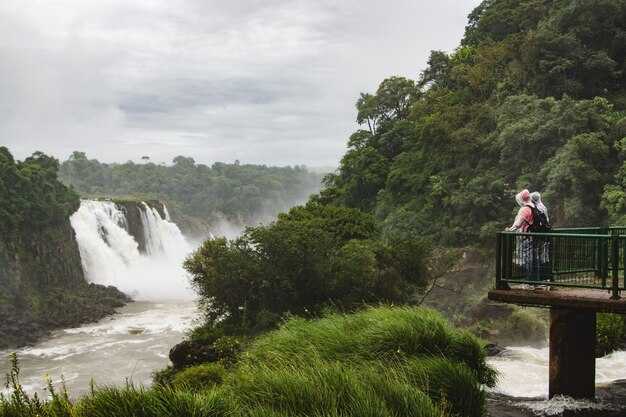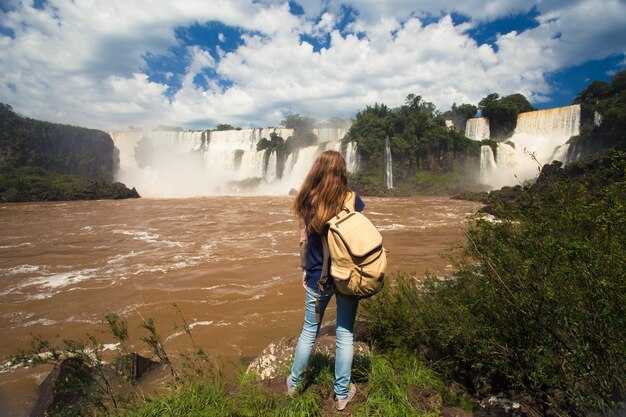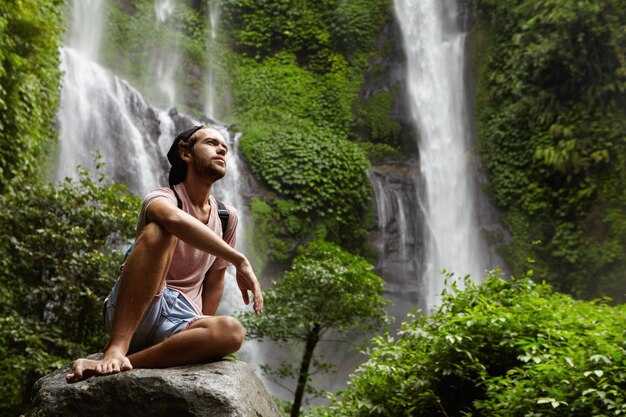advice: arrive before 9 am to enjoy cooler temperatures and clearer viewpoints on the Brazilian side. If you have arrived, head straight to the upper decks to catch the spray without long lines. Plan your route to maximize short walks between shaded spots and bring a light backpack with sunscreen and a microfiber towel.
Find your base: The belmond Hotel das Cataratas on the Brazilian side offers easy access to the park entry. If you lean toward budget options, frequent hostels around Foz do Iguaçu keep daily costs reasonable. michaela, an australian traveler, says a flexible plan and conversation with staff unlock quiet paths after rain. bring an amount for local taxis or shuttle buses, and reserve a couple of hours for a relaxed morning walk.
What to wear and pack: Wear sturdy shoes with grip for slippery stones. dont forget a lightweight rain jacket; the spray from the falls sticks to everything. Pack a compact poncho, bottled water, and a small power bank for photos. A daily plan helps you hit viewpoints in the best light, especially as temperatures rise.
Plan your route: Start at the main Brazilian circuit and work your way to the Garganta do Diabo overlook. Use the park shuttle to hop between trailheads, especially in peak heat. Look for wildlife, like toucans and coatis, along shaded stretches. A well-timed visit in the morning or late afternoon yields better lighting for photos.
Practical tips: Bring protection for cameras; the spray can fog lenses. dont rely on data connectivity in the park; download offline maps beforehand. The amount of walking is moderate but stairs add up; take breaks and hydrate. Consider a late-afternoon viewpoint, when temperatures drop again and mist creates rainbows.
Best Time to Visit the Brazilian Side for Garganta do Diabo Viewpoints
Plan your visit for May or September and start before 9 a.m. to catch Garganta do Diabo viewpoints on the Brazilian side with soft light and thinner crowds.
In these dry-season months, the wide catwalk stays dry, the air is comfortable, and visibility is best for photography. If you come in summer, be ready for higher humidity and occasional showers that heighten the mist and create dramatic portraits; the views remain powerful, especially in early morning light or late afternoon when the land and forest contrast most.
weve found that morning visits pay off: over the years, travelers have learned to optimize timing by starting early; weekdays are generally calmer; backpackers and local guests mix with day-trippers on weekends, but the quieter hours are still present. To simplify logistics, use rideshare from town to the park entrance, a reliable means to avoid parking hassles. On-site facilities provide a simple lunch option at the gate, but for a fuller meal you can purchase in town or at a nearby mall after your visit. wifi coverage is strongest near the main plaza; along the main catwalks it can be spotty, so download offline maps in advance. At the gate you obtain a map and can purchase tickets online to start smoothly. The Garganta route on the Brazilian side is wide and well-maintained, with viewpoints that place you between the spray and the forest land; some overlook on the opposite bank offer a different perspective if you plan a separate day trip to the Argentine side.
Timing and viewpoints
- Start early: aim for 7:00–9:00 a.m. to beat crowds and catch the best light.
- Prefer May or September for lower rainfall and comfortable temperatures, with strong water flow still present.
- Choose weekdays when possible; weekends draw backpackers and families, increasing crowding at key lookouts.
- Check the weather and park alerts the night before; morning mists can affect visibility if you start too late.
Practical planning

- Wear sturdy shoes for a wide, well-maintained path that remains mostly flat but can be slick after rain; plan for tiny spray droplets on skin and glasses.
- Pack light rain gear, sunscreen, and a small backpack; dorm-style hostels around town offer budget options if you’re traveling with a group.
- Purchase tickets online in advance to start your day smoothly; at the gate you can obtain a map and you’ll see coverage updates on-site.
- Use rideshare means to reach the entrance; it’s a common, cost-effective option for solo travelers and groups.
- Be mindful of wifi coverage: stay offline with maps if the signal is weak on the trails; download the route beforehand.
- Consider adding a second day to explore the Argentine side for a fuller variety of viewpoints between the two countries.
Getting There: From Foz do Iguaçu to the Brazilian Park Entrance
Book a private transfer or use a reliable taxi to reach the Brazilian Park Entrance quickly. From Foz do Iguaçu to the entrance, expect about 25–30 km of road, 30–45 minutes in light traffic; peak times can stretch it to 60 minutes. If you arrive via the IGU airport or other area airports, a pre-booked shuttle or taxi offers door-to-gate service, saving you stops and backtracking. Here’s a practical approach that keeps everyone on track.
Two solid ride options: private transfer or public bus
Option A: Private transfer. A driver waits in the arrivals hall at IGU or at your hotel and delivers you directly to the Park Entrance. Expect to pay around R$80–120 one way, depending on your hotel location and traffic; it’s better to pay a bit more for reliability, especially with kids or a lot of gear. If you’re traveling with others, the per-person cost drops and the space helps you pack everything you need. Passengers appreciate the convenience after travel, and the driver can stop for a quick photo along the road if you ask.
Option B: City bus. From downtown Foz, Bus 120 Cataratas runs roughly every 30–40 minutes and stops at the park gate. The ride takes about 60–75 minutes and costs around R$5–7. Board at the Terminal de Ônibus or at major urban stops; you’ll avoid parking hassles but share the ride with other passengers. If you missed the first bus, there are later departures–check the current timetable at your hotel or the terminal; plan to arrive early to beat the heat and crowds. Instead, if you’re on a tight budget, this is a better choice for the day.
There, crossing to the argentinean side is optional but can be a good complement in a full day. If you decide to cross, bring your passport and be prepared for customs checks; plan a separate entry and exit window, and note that afternoon temperatures can rise a few Fahrenheit degrees. If you want to explore ciudad neighborhoods on the other side, do it after you finish here and return for the Brazilian gates.
Practical packing and planning: pack light, leave bulky bags at the hotel if possible, and carry a small water bottle; the weather on the Brazilian side is sunny most days. In summer, temperatures often peak in the 80s or 90s Fahrenheit, so sunscreen, a hat, and a light jacket for cooler mornings help. The entry plaza is a short walk from the bus stop, but you’ll do more walking inside the park beyond the gate. Here, the shortest walk from the gate to the main outlooks takes about 15–25 minutes. If you’re touring with kids, pace yourself and add rests; everyone benefits from a relaxed rhythm. Create a simple itinerary list to guide your day, then review it at the bus stop to learn about current conditions and time windows, and leave some buffer for unexpected stops with others who share tips and plans.
Finally, a quick note to add to your plan: begin at the entrance, buy tickets, and consider the electric train for faster access to the most famous viewpoints on the Brazilian side. The vistas are amazing, and mornings offer softer light for photos. If you want a special day that blends park scenery with city culture, this route is worth the effort. The plan is straightforward, practical, and designed for smooth travel; by following these steps, you’ll avoid delays and enjoy the falls with less stress.
Ticketing, Parking, and Entrance Logistics for Garganta do Diabo
Purchase tickets online in advance and select an earlier time slot to make the visit easier and to avoid crowded queues during peak months.
Ticketing options on the official site include single-entry passes and combination experiences. Price varies by age and country of residence, with exchange rates available at checkout. The site accepts cards and cash, and the counter at the entrance can process exchanges for nearby networks if necessary.
Parking near the entrance is limited. Lot A sits closest to the Brazil-side entry, while Lot B is about a kilometre away along a walkable path. Expect hourly rates, with payment possible at the booth or via a mobile app. Plan for 1–2 hours if you want to explore both circuits and the lookout points without rushing.
Entrance logistics place you at a controlled gateway for Garganta do Diabo. Gates open early and close in the late afternoon; bring only essential belongings to speed checks, as staff conduct standard security inspections. Have your requirements ready–photo IDs, tickets, and any permitted tech–while keeping belongings compact to avoid intrusive lines. Use the main walkway and circuit route to reach the famous lookout without backtracking.
Local guidance from avid visitors adds value: Silva, a guide from Barroso, suggests starting at the lower circuit lookout to catch the best light, then following the walkways along the main circuit. The route is walkable for most guests, with a comfortable kilometre-scale stretch between lookouts. After the falls, many travelers enjoy a relaxed dinner nearby before departing for the airports or hotels in the country.
| Categoria | Recomendação | Notas |
| Ticketing | Book online; choose morning slot; print or save on phone | Price varies by country and age; exchange available at counter |
| Parking | Use Lot A near entry; Lot B is a short kilometre walk | Pay hourly; app or gate; plan 1–2 hours |
| Entrance | Arrive early; carry only essentials | Security checks are standard; lookouts along the walkway |
| Dicas | Bring water, wear walkable shoes, consider a dinner stop after | Avid photographers will appreciate early light; Silva recommends route via lower circuit |
The Main Trail: Distances, Prime Viewpoints, and Walking Time to Devil’s Throat
Start at the entrance and walk directly toward Garganta do Diabo; this one-way segment conveniently sets you up for the final platform and definitely feels efficient for most visitors.
A Trilha Principal para a Garganta do Diabo abrange aproximadamente 2 km em um sentido, com um ritmo ao ar livre confortável que rende cerca de 40–50 minutos de caminhada. Se você planeja demorar em cada mirante e tirar muitas fotos, reserve de 60 a 90 minutos para a abordagem completa à plataforma final.
Pontos de Vista Primários e a Extensão Ambulante
Após cerca de 0,7–0,9 km, o primeiro miradouro apresenta uma ampla vista das cascatas inferiores e do spray que cria arco-íris em luz brilhante. Continuando mais 0,5–0,6 km, chega-se a uma plataforma a meio do trilho com um panorama mais amplo sobre o rio e as margens florestadas.
A plataforma final da Garganta do Diabo chega por volta da marca dos 2 km, proporcionando a vista mais alta e emocionante da cascata em ferradura. Este é o momento alto e dramático que todos fotografam, com vapor na brisa e uma escala dramática que faz com que o resto da trilha valha a pena.
Ao longo do percurso, você encontrará assentos e locais sombreados para descansar, tornando a caminhada mais confortável para famílias e qualquer pessoa atenta ao calor ou ao sol. Para necessidades de mobilidade, pergunte no centro de visitantes sobre o acesso assistido por elevador aos terraços superiores; algumas seções oferecem acesso por rampa ou rotas alternativas ao deck principal.
Se você visitar de manhã ou à tarde, a sombra e os assentos ajudam você a manter um ritmo constante. Dos mirantes, você verá o rio se espalhar para o noroeste e a selva circundante, com avistamentos de vida selvagem possíveis durante as horas mais calmas. Procure placas em espanhol e português que rotulem as distâncias e mantenha os mapas à mão para um plano detalhado de suas paradas específicas. Se você estiver se sentindo energizado, cada mirante se torna uma atividade ao ar livre, transformando o próprio caminho em uma excursão compacta.
Este plano é seu para adaptar ao seu ritmo e interesses. Se você estiver hospedado na área, restaurantes próximos oferecem refeições rápidas antes ou depois da caminhada; se você estiver com pouco tempo, pode encurtar o percurso voltando após o primeiro ou segundo mirante e ainda capturar os destaques essenciais.
O que vestir e o que levar para caminhadas na floresta tropical
Comece com calças ou calções de secagem rápida e um casaco impermeável e respirável; use sapatos resistentes e fechados com boa aderência. Se planeia uma transferência de bicicleta ou um pequeno passeio entre locais, escolha calçado com um ajuste seguro e leve luvas.
O uso de camadas ajuda: uma camada de base que absorve a umidade, uma camada intermediária leve e uma capa de chuva compacta. O que você veste depende da previsão e da sua tolerância à umidade; as manhãs são mais frias e podem aquecer rapidamente em altitudes mais elevadas. A chuva pode chegar rapidamente, então esteja preparado.
O Que Levar na Mala
A partir da entrada, leve uma mochila de dia de 8 a 12 litros com uma bolsa estanque para eletrónicos. Leve uma garrafa de água ou um sistema de hidratação; procure ter pelo menos 1,5 litros para uma caminhada de 60 a 90 minutos.
Proteção solar: chapéu, óculos de sol, protetor solar. Proteção contra insetos: repelente. Proteção contra chuva: poncho ou jaqueta de chuva leve se sua mochila não tiver capa.
Capa à prova d'água para um telefone ou câmera; baterias sobressalentes; uma barra de cereais para energia.
termas estão por perto, então traga uma toalha se houver um plano para visitar termas após a caminhada.
Leve dinheiro em pesos para áreas de fronteira; a maioria das compras dentro do parque aceita cartões, mas algumas barracas dependem de dinheiro. Para acomodação e refeições, há hotéis e restaurantes nas proximidades; planeje-se adequadamente.
Visitantes nacionais e internacionais podem organizar transfers e táxis do lado de fora da entrada; o horário de funcionamento varia conforme a estação. A maioria dos circuitos leva de 60 a 90 minutos; há dias movimentados, portanto, reserve alguns minutos extras para pontos de fotos e mirantes.
Dicas de Fotografia: Capturando as Cataratas do Iguaçu pelo Lado Brasileiro
Vá para a área do Porto ao amanhecer para um spray fresco e luz quente na plataforma de salto; mantenha uma lente rápida pronta e limpe a humidade do seu filtro frequentemente para manter arestas nítidas no nevoeiro. Desenvolva hábitos de fotografia: verifique a luz a cada poucos minutos e varra a cena antes de se comprometer, para não perder um arco-íris fugaz.
No lado brasileiro, as trilhas têm ângulos de visão limitados, então planeje um circuito de 60 a 90 minutos para cobrir os principais mirantes e os caminhos internos do dossel. Verifique os horários atualizados do parque e as partidas para alinhar sua programação com os momentos mais tranquilos; a data e o clima moldam os reflexos, e as condições gerais podem mudar rapidamente. Se você estiver combinando viagens nas missões, coordene com cuidado, mas permaneça flexível para evitar multidões intrusivas. Use isto como base para planejar sua rota para maximizar a luz solar em cada vista.
Dentro do parque, multidões podem ser intrusivas perto das plataformas principais; procure fotografar logo após um jato, depois entre nas bordas exuberantes para enquadramentos íntimos perto da água. Tenha cuidado com a vida selvagem ao longo das bordas, incluindo gatos. O estacionamento é conveniente perto da entrada, mas volte antes que as multidões do transporte atinjam o pico; você terá encontrado alguns ângulos surpreendentemente silenciosos ao longo das trilhas laterais e ficará feliz por ter usado calçados confortáveis para proteger seus pés.
Melhores momentos e pontos de vantagem
A luz ideal ocorre após o amanhecer; do ponto de vista do salto, você poderá ver um arco-íris conforme o sol sobe. De alguns mirantes, você verá enormes vistas da cortina de água e, em seguida, seguirá pelo calçadão para emoldurar as cataratas enquanto a névoa se espalha pela floresta. Para silhuetas extremamente dramáticas, demore-se até o final da manhã e novamente no final da tarde, quando as sombras se estendem ao longo da cascata. Considere uma segunda passagem no circuito interno para capturar fitas de água através das árvores. No geral, escolha alguns pontos-chave e use um tripé leve para evitar oscilações no calçadão, sempre deixando espaço para perseguir a névoa que muda.
Engrenagem, configurações e planejamento

Use uma lente grande angular (16-35mm) para panoramas e uma tele média (70-200mm) para detalhes próximos das lâminas d'água e auras nebulosas. Defina a exposição em torno de f/8–f/11 e ISO 100–200; para água sedosa, tente 1–2 segundos com um tripé resistente ou mude para velocidades de obturador mais rápidas se o vento mudar o spray. Um polarizador ajuda a cortar o brilho em dias claros, e um filtro de densidade neutra estende suas longas exposições. Fotografe em RAW e use aplicativos para mapear trilhas, verificar estacionamento e rastrear janelas de data/hora e partidas. Se você ficar por perto, uma janela de 2 a 3 horas se adapta a um ritmo relaxado; para viagens familiares, mantenha os segmentos curtos e permita uma opção extravagante para uma estadia de luxo nas proximidades. Se você combinar viagens de missões ou combinar viagens, encontrará mais paisagens e menos esperas. Termine com uma rápida verificação dos pés: recue para avaliar a escala e proteger seu equipamento do spray.



Comentários